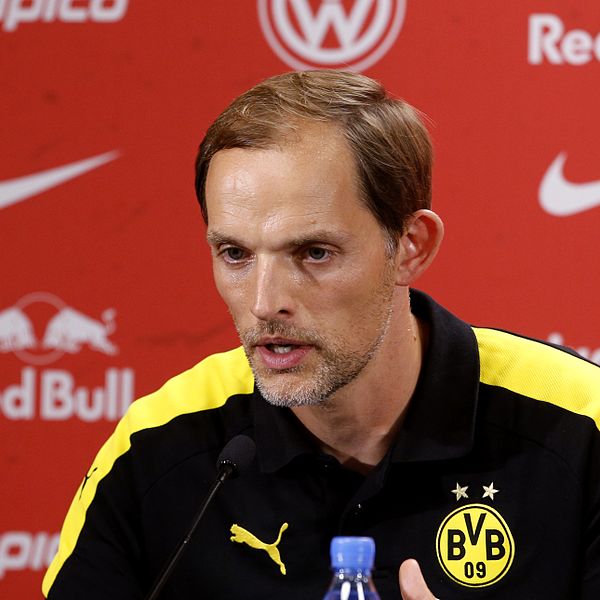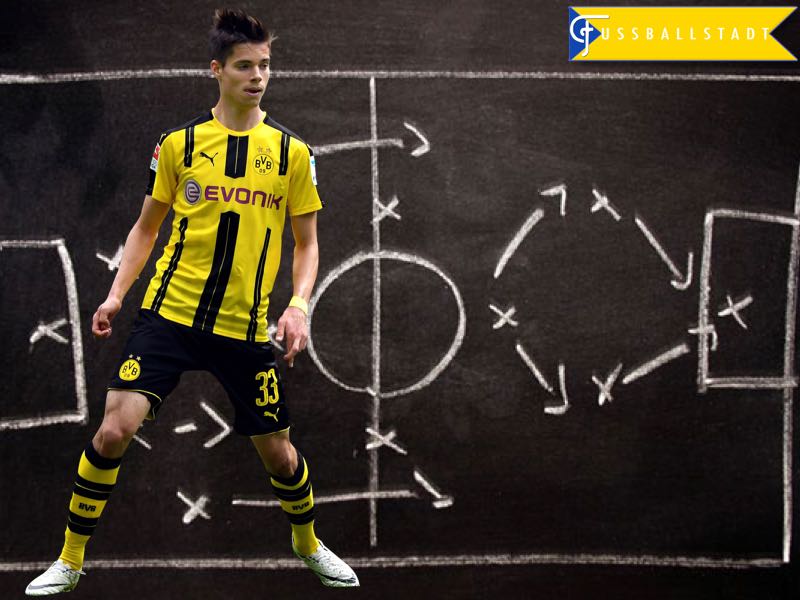Manuel Veth - Julian Weigl’s rise to the top of the game has been meteoric. In 2014-15 he was playing with TSV 1860 Munich against relegation from Bu
Manuel Veth –
Julian Weigl’s rise to the top of the game has been meteoric. In 2014-15 he was playing with TSV 1860 Munich against relegation from Bundesliga 2. Then last summer, he was a member of the German national team that travelled to France to represent the country at the European Championships.
In between, Julian Weigl became the key component in Thomas Tuchel’s side that finished second in the 2015-16 Bundesliga season. Dortmund, in fact, with 78 points (2.29 on average) Dortmund was only second to Real Madrid’s 90 points (2.36 points on average) in any of Europe’s top five leagues last season.
The fantastic work done by Tuchel, and the importance of Weigl’s rise to become the key piece in one of Europe’s most prolific midfields was therefore somewhat overshadowed by another impressive season by Bayern München, who collected an unreal 88 points in 34 games last season (2.58 on average). The now 21-year-old played 30 Bundesliga games in his first season with Borussia Dortmund where he had an average passing completion rate of 91.9%.
Julian Weigl is a Schlüsselspieler
Tuchel would often use a 4-1-4-1 formation with Weigl sitting between the back four, and the four-man midfield, and while Mats Hummels was in charge in creating quick counter attacks with his long range passes from the back, Weigl, meanwhile, was the key-man, or Schlüsselspieler in German, in Borussia’s Kurzpassspiel, or short passing game, in midfield, as he played a role not unlike of what Xavi did for many years at Barcelona.

Julian Weigl was several times linked with a move to Pep Guardiola’s Bayern – Image by Niklas B. CC-BY-2.0
Weigl, in many ways, is the ideal player for any coach, who wishes to control the match with short passes, and it was, therefore, no coincidence that Weigl was often linked with a transfer to Bayern München and, after Pep Guardiola’s move to England was announced, to Manchester City. But Thomas Tuchel and Pep Guardiola are understood to represent the same playing philosophy.
Guardiola even recommended Tuchel, as his successor at Bayern München. The two are understood to have had a meeting at the high end Munich Käfer Restaurant where they discussed tactics—a meeting from which Guardiola seemed to walk away impressed.
It was under Guardiola that Xavi and Iniesta became the key players in Barcelona’s midfield. Last season, it appeared that Weigl was, in many ways, following the same path under Tuchel, and Dortmund’s game was close to perfect.
Despite defeating Borussia Mönchengladbach 4-1 on matchday 13, Borussia are somewhat lacking the dominance they displayed for much of last season. Some of it is due to the fact that Dortmund have made some significant changes in the offseason.
Dortmund play different without Hummels in the lineup
Borussia Dortmund had to compensate for the departure of Hummels, Ilkay Gündogan, and Henrikh Mkhitaryan, by spending a staggering €109.75 million on not only such established stars as André Schürrle, Mario Götze, Marc Bartra, and Sebastian Rode, but also by signing a bucket load of young talent that includes the likes of Ousmane Dembélé, Raphaël Gurreiro, and Emre Mor, thereby adding to a squad that already included young stars like Felix Passlack, and American sensation Christian Pulisic.
The departure of three key players, and the influx of many young players meant that Dortmund displayed some inconsistency in the Bundesliga this season. Some of it was due to the fact that the young signings, especially, had to adapt to the tempo in the Bundesliga, and also that the many new players had to find chemistry with one another.
Some of the new signings, like Mario Götze, André Schürrle, and Gurreiro, also struggled a bit with match fixing in the early goings of the season. But perhaps the biggest change for Weigl, in particular, was the departure of Mats Hummels.
Hummels, last season, was the key player when it came to providing a long-range outlet when Weigl was unable to connect with his midfield partners. Hummels, however, departed to Bayern München, and his replacement, Marc Bartra, although without a doubt enormously talented, has not yet filled the void left by the German defender.
Bartra has, at times, demonstrated that he can also play a long-range pass but, as a graduate of the Barcelona La Masia academy, Bartra like Weigl prefers the short passing game. This has meant that it is easier to decipher Borussia Dortmund, as teams have identified Weigl, as the key component when trying to to shut down Dortmund’s attacking machinery.
Opposing teams now target Julian Weigl
In practice, this means that opposing teams tend to target Weigl with opposing forwards and midfielders who try to challenge the midfielder by interrupting his play with physical play. Against Eintracht Frankfurt this task fell to Alex Meier, Mijat Gaćinović, and Makoto Hasebe, who interrupted Weigl’s midfield play which brought Dortmund’s attacking game to a stuttering halt.
Another example is Borussia Dortmund’s game against RB Leipzig where Ralph Hasenhüttl’s side tends to collectively press high, making it difficult for Julian Weigl to build up Dortmund’s attacking play. Here Timo Werner, Marcel Sabitzer, and Yussuf Poulsen, in particular, made life difficult for Weigl. Dortmund never found a foothold in the match and, in the end, Oliver Burke and Naby Keïta combined for the winner.
Against Frankfurt, Tuchel took Weigl off early in the second half replacing him with the more physical Sebastian Rode in an attempt to bring more physical elements into Dortmund’s game. In the end, it was Rode who gave away the key ball in midfield, which led to Eintracht Frankfurt’s winning goal. But Weigl was identified, as the key problem in Dortmund’s early woes against Frankfurt.

Julian Weigl can be for Thomas Tuchel what Xavi was for Pep Guardiola at FC Barcelona – Image by Alexander Böhm CC-BY-SA-4.0
It was therefore no surprise that Thomas Tuchel elected to make some changes ahead of the game against Borussia Mönchengladbach, as Gladbach’s Borussia under André Schubert also tends to play what Germans call Jagdfußball (collective high pressure). Tuchel, therefore, benched Weigl for the game and, instead, elected to play the more physical Matthias Ginter in between a four-man defence, and a four-man midfield.
In fact, at times Dortmund’s formation looked like a 3-4-3 formation with Ginter dropping into a back-three, with left-back Marcel Schmelzer, and right-back Lukas Piszczek pushing forward into a four-man midfield. This formation meant that Dortmund was more flexible in countering Gladbach’s high line, as Ginter acted both like a deep playmaker, but also as a rock to break up Gladbach’s attacking plays.
In the four-man midfield Nuri Sahin, and Gonzalo Castro acted as the double playmakers in the centre, which made it harder for Gladbach to shut down Dortmund’s attacking play. Sahin, however, had to come off after 36 minutes with an injury, which made room for Julian Weigl.
Julian Weigl needs to become more physical himself
The formation, however, meant that the play was not resting on Weigl’s shoulders, and Dortmund was able to outperform Gladbach, winning the match 4-1. Yet, there are lessons in the game, as Weigl, and Dortmund have to find ways to keep Weigl an effective part of the midfield formation.
On paper, the 21-year-old remains one of the most effective passing machines in the Bundesliga with a pass completion rate of 90.9% (93.9% in the Champions League). Tactical changes like against Gladbach are one solution, but Weigl also needs to learn to adapt to being on the receiving end of more physical play.
At 186cm and just 72kg Weigl cuts a majestic figure on the pitch, which is reminiscent of Franz Beckenbauer at times, but he needs to learn to fight off physical play to stay effective.
Manuel Veth is a freelance journalist, writer for Bundesliga.com, and podcaster for WorldFootballIndex.com. He is also a holder of a Doctorate of Philosophy in History from King’s College London, and his thesis is titled: “Selling the People’s Game: Football’s transition from Communism to Capitalism in the Soviet Union and its Successor States”, which will be available in print soon. Originally from Munich, Manuel has lived in Amsterdam, Kyiv, Moscow, Tbilisi, London, and currently is located in Victoria BC, Canada. Follow Manuel on Twitter @homosovieticus.


COMMENTS